Investigating Gender Pay Gaps in the New Zealand Workplace
VerifiedAdded on 2022/10/17
|15
|3940
|10
Report
AI Summary
This report provides a comprehensive analysis of the gender pay gap in New Zealand workplaces. It begins by introducing the issue and its significance, followed by a discussion of relevant theoretical frameworks, including the human capital model, Becker's discrimination model, and the crowding model, to explain the underlying causes of pay disparities. The report then presents findings supported by statistical data and empirical evidence, illustrating the instances of gender pay gaps in various sectors within New Zealand. Furthermore, it offers practical recommendations for new companies to address and mitigate these disparities from the outset. The report concludes by summarizing the key insights and implications of the gender pay gap in the New Zealand context, making it a valuable resource for entrepreneurs, policymakers, and researchers interested in understanding and addressing this persistent issue.
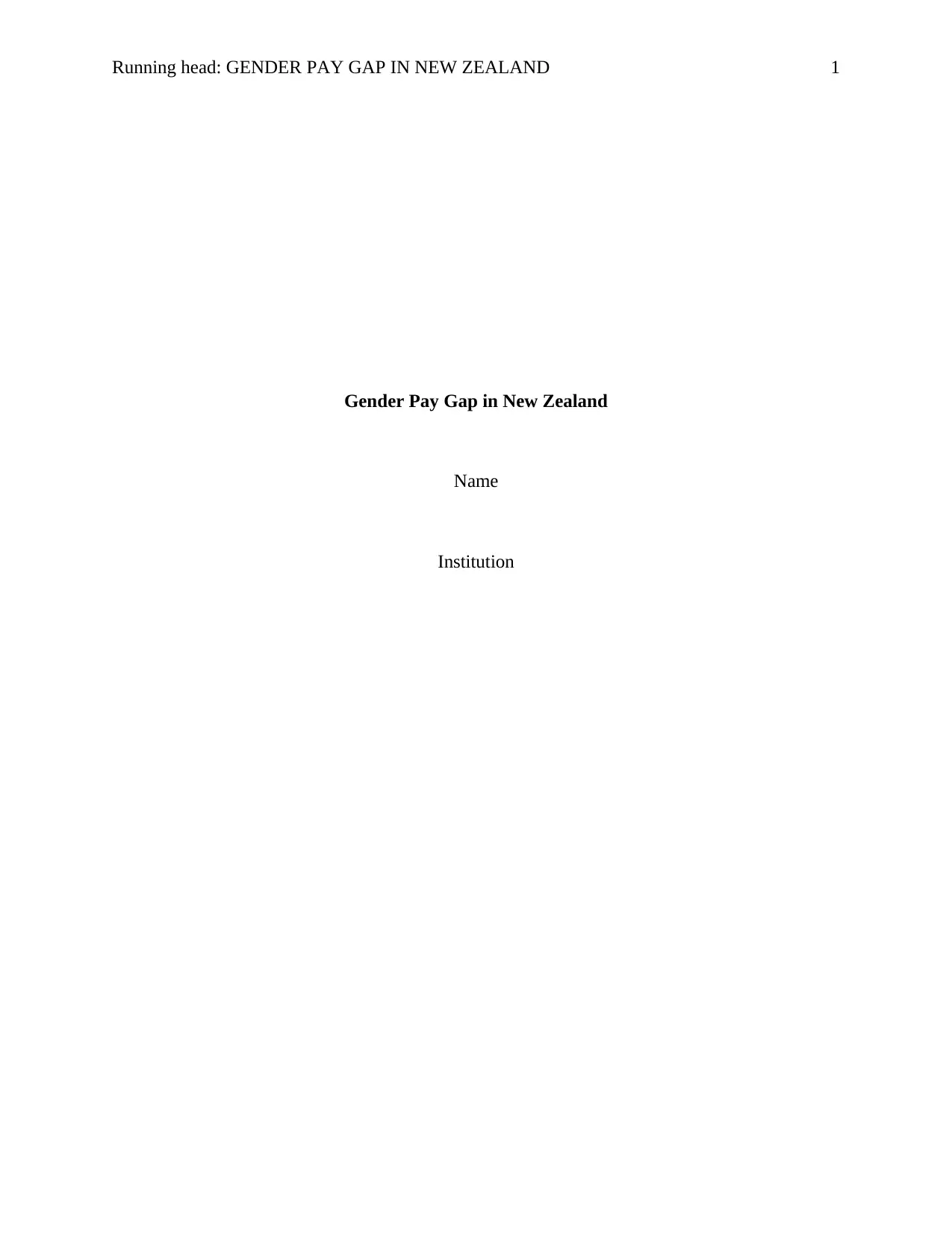
Running head: GENDER PAY GAP IN NEW ZEALAND 1
Gender Pay Gap in New Zealand
Name
Institution
Gender Pay Gap in New Zealand
Name
Institution
Paraphrase This Document
Need a fresh take? Get an instant paraphrase of this document with our AI Paraphraser
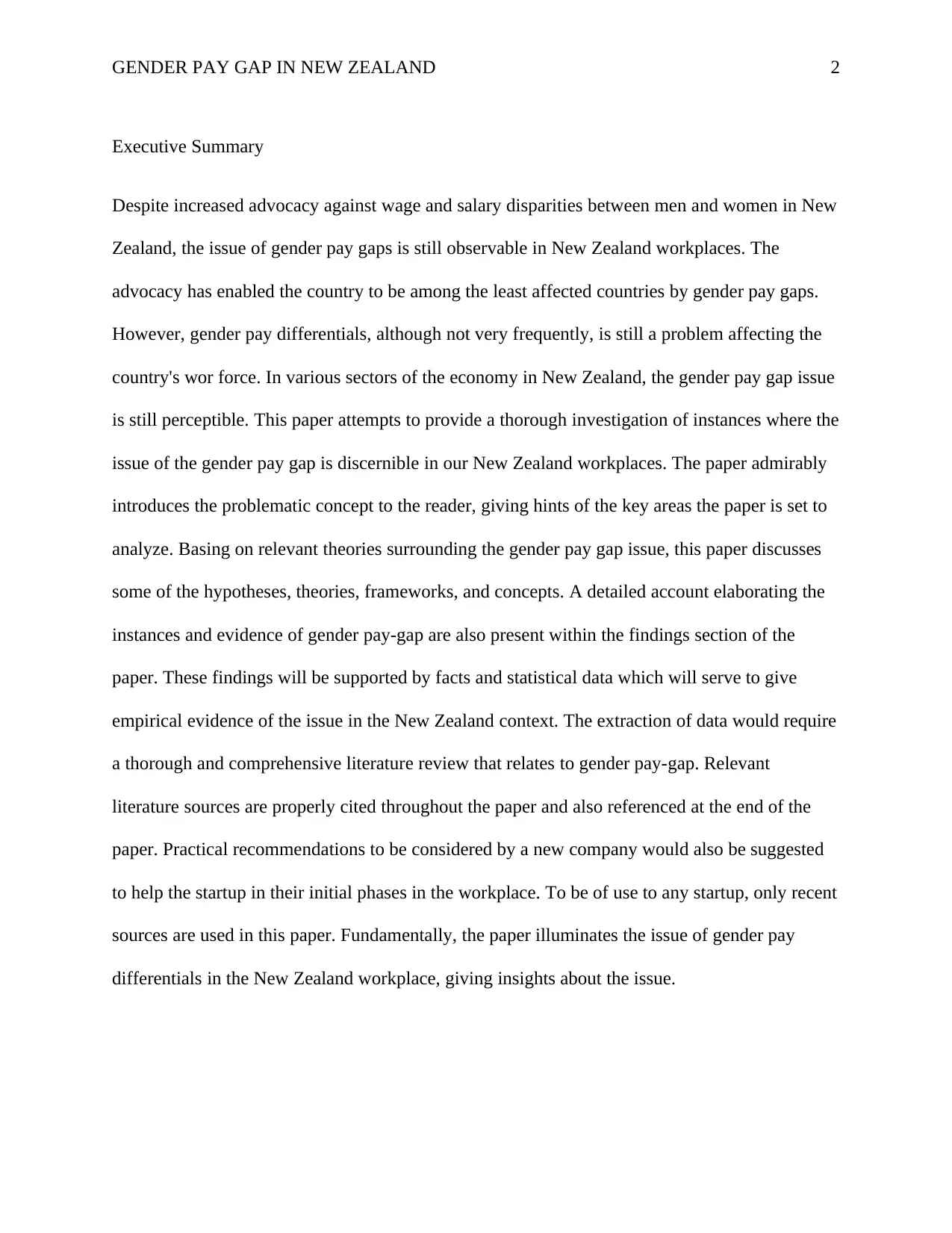
GENDER PAY GAP IN NEW ZEALAND 2
Executive Summary
Despite increased advocacy against wage and salary disparities between men and women in New
Zealand, the issue of gender pay gaps is still observable in New Zealand workplaces. The
advocacy has enabled the country to be among the least affected countries by gender pay gaps.
However, gender pay differentials, although not very frequently, is still a problem affecting the
country's wor force. In various sectors of the economy in New Zealand, the gender pay gap issue
is still perceptible. This paper attempts to provide a thorough investigation of instances where the
issue of the gender pay gap is discernible in our New Zealand workplaces. The paper admirably
introduces the problematic concept to the reader, giving hints of the key areas the paper is set to
analyze. Basing on relevant theories surrounding the gender pay gap issue, this paper discusses
some of the hypotheses, theories, frameworks, and concepts. A detailed account elaborating the
instances and evidence of gender pay-gap are also present within the findings section of the
paper. These findings will be supported by facts and statistical data which will serve to give
empirical evidence of the issue in the New Zealand context. The extraction of data would require
a thorough and comprehensive literature review that relates to gender pay-gap. Relevant
literature sources are properly cited throughout the paper and also referenced at the end of the
paper. Practical recommendations to be considered by a new company would also be suggested
to help the startup in their initial phases in the workplace. To be of use to any startup, only recent
sources are used in this paper. Fundamentally, the paper illuminates the issue of gender pay
differentials in the New Zealand workplace, giving insights about the issue.
Executive Summary
Despite increased advocacy against wage and salary disparities between men and women in New
Zealand, the issue of gender pay gaps is still observable in New Zealand workplaces. The
advocacy has enabled the country to be among the least affected countries by gender pay gaps.
However, gender pay differentials, although not very frequently, is still a problem affecting the
country's wor force. In various sectors of the economy in New Zealand, the gender pay gap issue
is still perceptible. This paper attempts to provide a thorough investigation of instances where the
issue of the gender pay gap is discernible in our New Zealand workplaces. The paper admirably
introduces the problematic concept to the reader, giving hints of the key areas the paper is set to
analyze. Basing on relevant theories surrounding the gender pay gap issue, this paper discusses
some of the hypotheses, theories, frameworks, and concepts. A detailed account elaborating the
instances and evidence of gender pay-gap are also present within the findings section of the
paper. These findings will be supported by facts and statistical data which will serve to give
empirical evidence of the issue in the New Zealand context. The extraction of data would require
a thorough and comprehensive literature review that relates to gender pay-gap. Relevant
literature sources are properly cited throughout the paper and also referenced at the end of the
paper. Practical recommendations to be considered by a new company would also be suggested
to help the startup in their initial phases in the workplace. To be of use to any startup, only recent
sources are used in this paper. Fundamentally, the paper illuminates the issue of gender pay
differentials in the New Zealand workplace, giving insights about the issue.
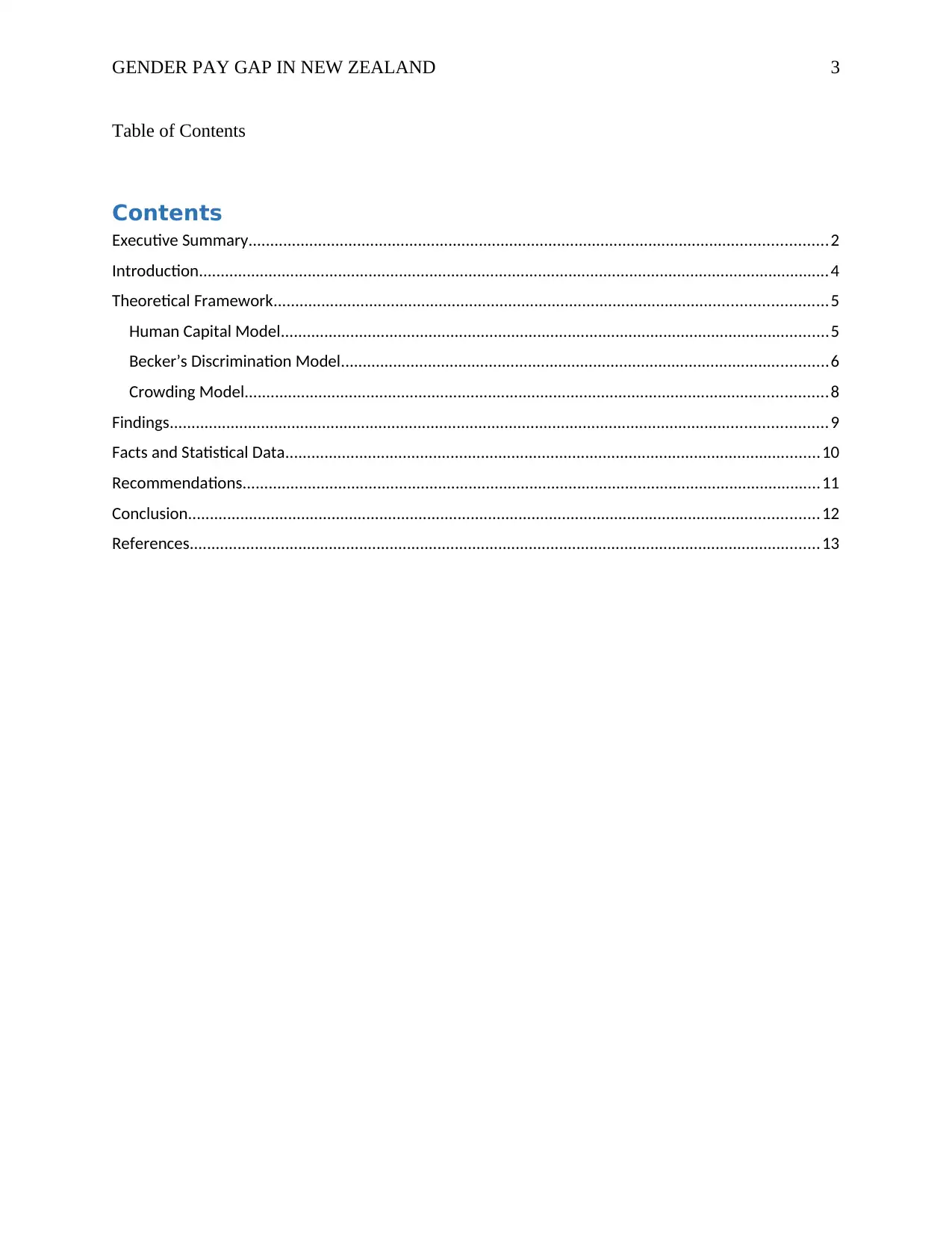
GENDER PAY GAP IN NEW ZEALAND 3
Table of Contents
Contents
Executive Summary.....................................................................................................................................2
Introduction.................................................................................................................................................4
Theoretical Framework...............................................................................................................................5
Human Capital Model..............................................................................................................................5
Becker’s Discrimination Model................................................................................................................6
Crowding Model......................................................................................................................................8
Findings.......................................................................................................................................................9
Facts and Statistical Data...........................................................................................................................10
Recommendations.....................................................................................................................................11
Conclusion.................................................................................................................................................12
References.................................................................................................................................................13
Table of Contents
Contents
Executive Summary.....................................................................................................................................2
Introduction.................................................................................................................................................4
Theoretical Framework...............................................................................................................................5
Human Capital Model..............................................................................................................................5
Becker’s Discrimination Model................................................................................................................6
Crowding Model......................................................................................................................................8
Findings.......................................................................................................................................................9
Facts and Statistical Data...........................................................................................................................10
Recommendations.....................................................................................................................................11
Conclusion.................................................................................................................................................12
References.................................................................................................................................................13
⊘ This is a preview!⊘
Do you want full access?
Subscribe today to unlock all pages.

Trusted by 1+ million students worldwide
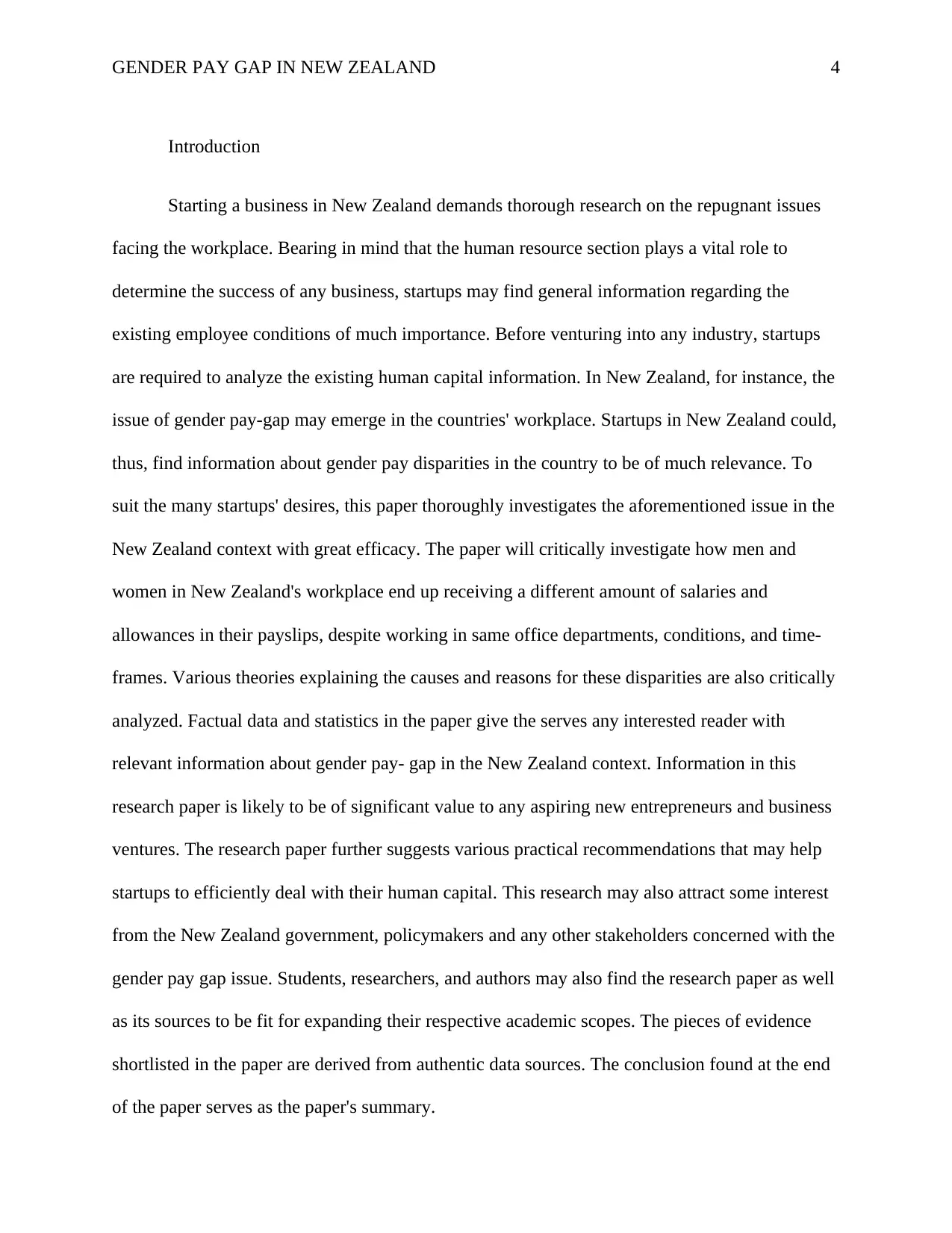
GENDER PAY GAP IN NEW ZEALAND 4
Introduction
Starting a business in New Zealand demands thorough research on the repugnant issues
facing the workplace. Bearing in mind that the human resource section plays a vital role to
determine the success of any business, startups may find general information regarding the
existing employee conditions of much importance. Before venturing into any industry, startups
are required to analyze the existing human capital information. In New Zealand, for instance, the
issue of gender pay-gap may emerge in the countries' workplace. Startups in New Zealand could,
thus, find information about gender pay disparities in the country to be of much relevance. To
suit the many startups' desires, this paper thoroughly investigates the aforementioned issue in the
New Zealand context with great efficacy. The paper will critically investigate how men and
women in New Zealand's workplace end up receiving a different amount of salaries and
allowances in their payslips, despite working in same office departments, conditions, and time-
frames. Various theories explaining the causes and reasons for these disparities are also critically
analyzed. Factual data and statistics in the paper give the serves any interested reader with
relevant information about gender pay- gap in the New Zealand context. Information in this
research paper is likely to be of significant value to any aspiring new entrepreneurs and business
ventures. The research paper further suggests various practical recommendations that may help
startups to efficiently deal with their human capital. This research may also attract some interest
from the New Zealand government, policymakers and any other stakeholders concerned with the
gender pay gap issue. Students, researchers, and authors may also find the research paper as well
as its sources to be fit for expanding their respective academic scopes. The pieces of evidence
shortlisted in the paper are derived from authentic data sources. The conclusion found at the end
of the paper serves as the paper's summary.
Introduction
Starting a business in New Zealand demands thorough research on the repugnant issues
facing the workplace. Bearing in mind that the human resource section plays a vital role to
determine the success of any business, startups may find general information regarding the
existing employee conditions of much importance. Before venturing into any industry, startups
are required to analyze the existing human capital information. In New Zealand, for instance, the
issue of gender pay-gap may emerge in the countries' workplace. Startups in New Zealand could,
thus, find information about gender pay disparities in the country to be of much relevance. To
suit the many startups' desires, this paper thoroughly investigates the aforementioned issue in the
New Zealand context with great efficacy. The paper will critically investigate how men and
women in New Zealand's workplace end up receiving a different amount of salaries and
allowances in their payslips, despite working in same office departments, conditions, and time-
frames. Various theories explaining the causes and reasons for these disparities are also critically
analyzed. Factual data and statistics in the paper give the serves any interested reader with
relevant information about gender pay- gap in the New Zealand context. Information in this
research paper is likely to be of significant value to any aspiring new entrepreneurs and business
ventures. The research paper further suggests various practical recommendations that may help
startups to efficiently deal with their human capital. This research may also attract some interest
from the New Zealand government, policymakers and any other stakeholders concerned with the
gender pay gap issue. Students, researchers, and authors may also find the research paper as well
as its sources to be fit for expanding their respective academic scopes. The pieces of evidence
shortlisted in the paper are derived from authentic data sources. The conclusion found at the end
of the paper serves as the paper's summary.
Paraphrase This Document
Need a fresh take? Get an instant paraphrase of this document with our AI Paraphraser
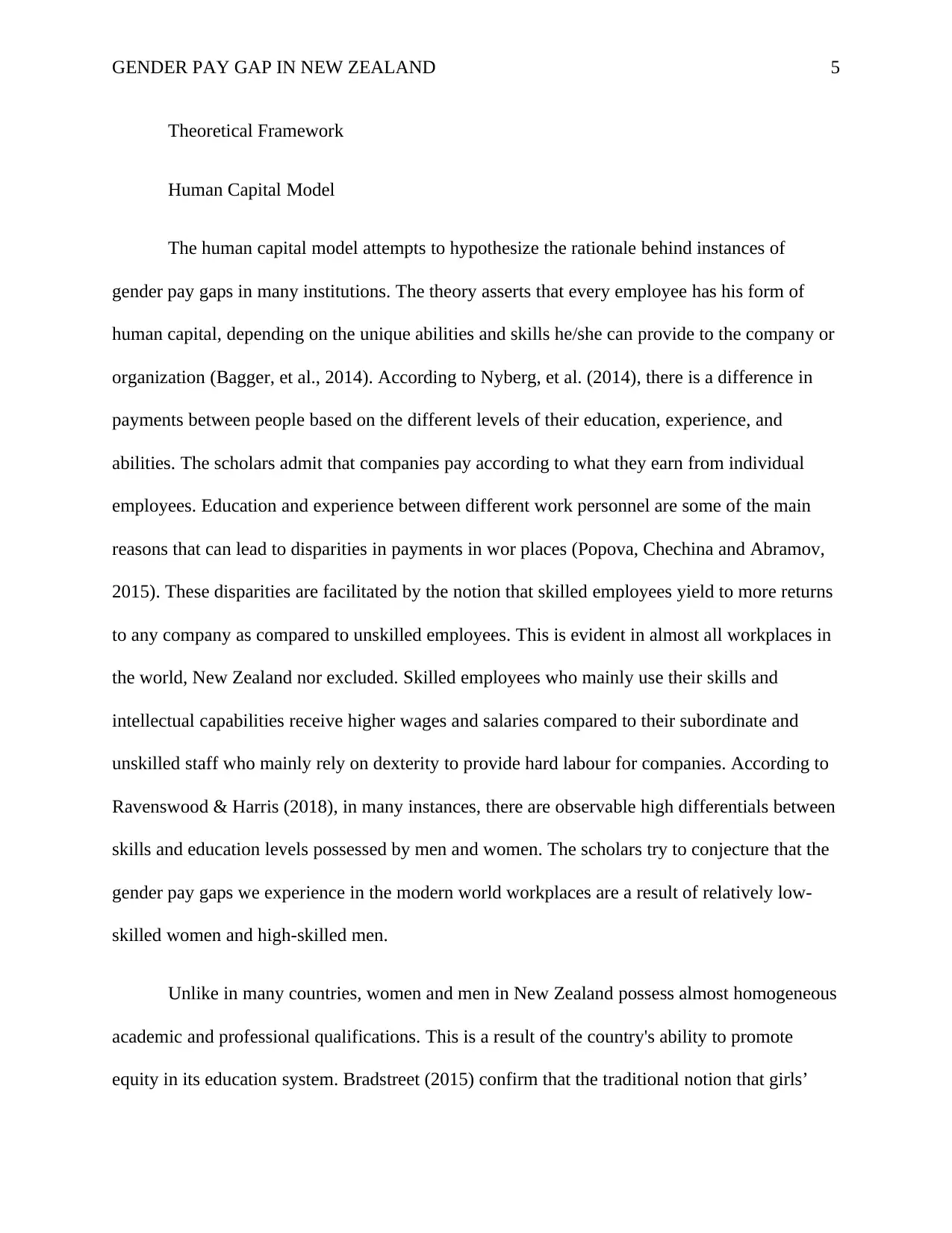
GENDER PAY GAP IN NEW ZEALAND 5
Theoretical Framework
Human Capital Model
The human capital model attempts to hypothesize the rationale behind instances of
gender pay gaps in many institutions. The theory asserts that every employee has his form of
human capital, depending on the unique abilities and skills he/she can provide to the company or
organization (Bagger, et al., 2014). According to Nyberg, et al. (2014), there is a difference in
payments between people based on the different levels of their education, experience, and
abilities. The scholars admit that companies pay according to what they earn from individual
employees. Education and experience between different work personnel are some of the main
reasons that can lead to disparities in payments in wor places (Popova, Chechina and Abramov,
2015). These disparities are facilitated by the notion that skilled employees yield to more returns
to any company as compared to unskilled employees. This is evident in almost all workplaces in
the world, New Zealand nor excluded. Skilled employees who mainly use their skills and
intellectual capabilities receive higher wages and salaries compared to their subordinate and
unskilled staff who mainly rely on dexterity to provide hard labour for companies. According to
Ravenswood & Harris (2018), in many instances, there are observable high differentials between
skills and education levels possessed by men and women. The scholars try to conjecture that the
gender pay gaps we experience in the modern world workplaces are a result of relatively low-
skilled women and high-skilled men.
Unlike in many countries, women and men in New Zealand possess almost homogeneous
academic and professional qualifications. This is a result of the country's ability to promote
equity in its education system. Bradstreet (2015) confirm that the traditional notion that girls’
Theoretical Framework
Human Capital Model
The human capital model attempts to hypothesize the rationale behind instances of
gender pay gaps in many institutions. The theory asserts that every employee has his form of
human capital, depending on the unique abilities and skills he/she can provide to the company or
organization (Bagger, et al., 2014). According to Nyberg, et al. (2014), there is a difference in
payments between people based on the different levels of their education, experience, and
abilities. The scholars admit that companies pay according to what they earn from individual
employees. Education and experience between different work personnel are some of the main
reasons that can lead to disparities in payments in wor places (Popova, Chechina and Abramov,
2015). These disparities are facilitated by the notion that skilled employees yield to more returns
to any company as compared to unskilled employees. This is evident in almost all workplaces in
the world, New Zealand nor excluded. Skilled employees who mainly use their skills and
intellectual capabilities receive higher wages and salaries compared to their subordinate and
unskilled staff who mainly rely on dexterity to provide hard labour for companies. According to
Ravenswood & Harris (2018), in many instances, there are observable high differentials between
skills and education levels possessed by men and women. The scholars try to conjecture that the
gender pay gaps we experience in the modern world workplaces are a result of relatively low-
skilled women and high-skilled men.
Unlike in many countries, women and men in New Zealand possess almost homogeneous
academic and professional qualifications. This is a result of the country's ability to promote
equity in its education system. Bradstreet (2015) confirm that the traditional notion that girls’
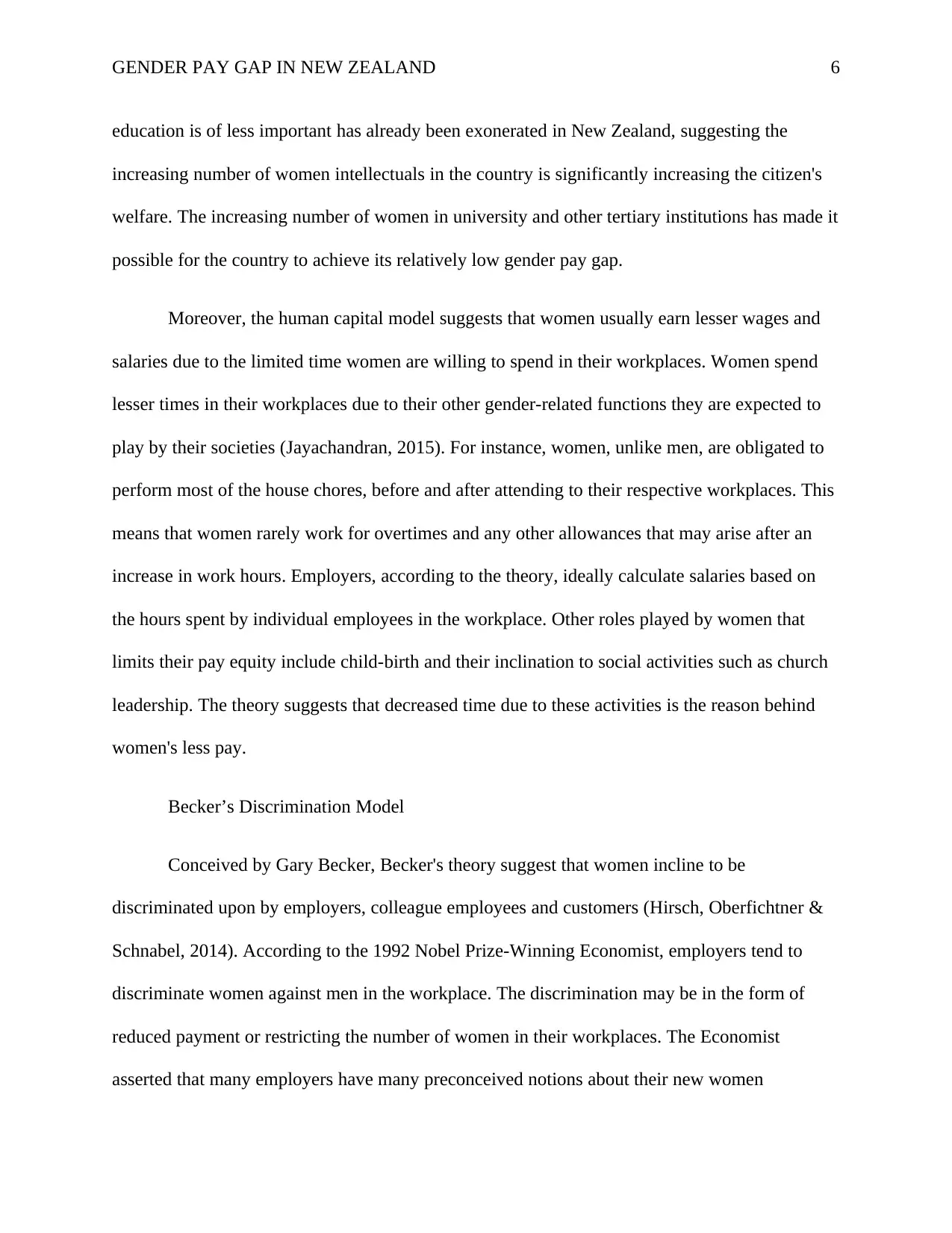
GENDER PAY GAP IN NEW ZEALAND 6
education is of less important has already been exonerated in New Zealand, suggesting the
increasing number of women intellectuals in the country is significantly increasing the citizen's
welfare. The increasing number of women in university and other tertiary institutions has made it
possible for the country to achieve its relatively low gender pay gap.
Moreover, the human capital model suggests that women usually earn lesser wages and
salaries due to the limited time women are willing to spend in their workplaces. Women spend
lesser times in their workplaces due to their other gender-related functions they are expected to
play by their societies (Jayachandran, 2015). For instance, women, unlike men, are obligated to
perform most of the house chores, before and after attending to their respective workplaces. This
means that women rarely work for overtimes and any other allowances that may arise after an
increase in work hours. Employers, according to the theory, ideally calculate salaries based on
the hours spent by individual employees in the workplace. Other roles played by women that
limits their pay equity include child-birth and their inclination to social activities such as church
leadership. The theory suggests that decreased time due to these activities is the reason behind
women's less pay.
Becker’s Discrimination Model
Conceived by Gary Becker, Becker's theory suggest that women incline to be
discriminated upon by employers, colleague employees and customers (Hirsch, Oberfichtner &
Schnabel, 2014). According to the 1992 Nobel Prize-Winning Economist, employers tend to
discriminate women against men in the workplace. The discrimination may be in the form of
reduced payment or restricting the number of women in their workplaces. The Economist
asserted that many employers have many preconceived notions about their new women
education is of less important has already been exonerated in New Zealand, suggesting the
increasing number of women intellectuals in the country is significantly increasing the citizen's
welfare. The increasing number of women in university and other tertiary institutions has made it
possible for the country to achieve its relatively low gender pay gap.
Moreover, the human capital model suggests that women usually earn lesser wages and
salaries due to the limited time women are willing to spend in their workplaces. Women spend
lesser times in their workplaces due to their other gender-related functions they are expected to
play by their societies (Jayachandran, 2015). For instance, women, unlike men, are obligated to
perform most of the house chores, before and after attending to their respective workplaces. This
means that women rarely work for overtimes and any other allowances that may arise after an
increase in work hours. Employers, according to the theory, ideally calculate salaries based on
the hours spent by individual employees in the workplace. Other roles played by women that
limits their pay equity include child-birth and their inclination to social activities such as church
leadership. The theory suggests that decreased time due to these activities is the reason behind
women's less pay.
Becker’s Discrimination Model
Conceived by Gary Becker, Becker's theory suggest that women incline to be
discriminated upon by employers, colleague employees and customers (Hirsch, Oberfichtner &
Schnabel, 2014). According to the 1992 Nobel Prize-Winning Economist, employers tend to
discriminate women against men in the workplace. The discrimination may be in the form of
reduced payment or restricting the number of women in their workplaces. The Economist
asserted that many employers have many preconceived notions about their new women
⊘ This is a preview!⊘
Do you want full access?
Subscribe today to unlock all pages.

Trusted by 1+ million students worldwide
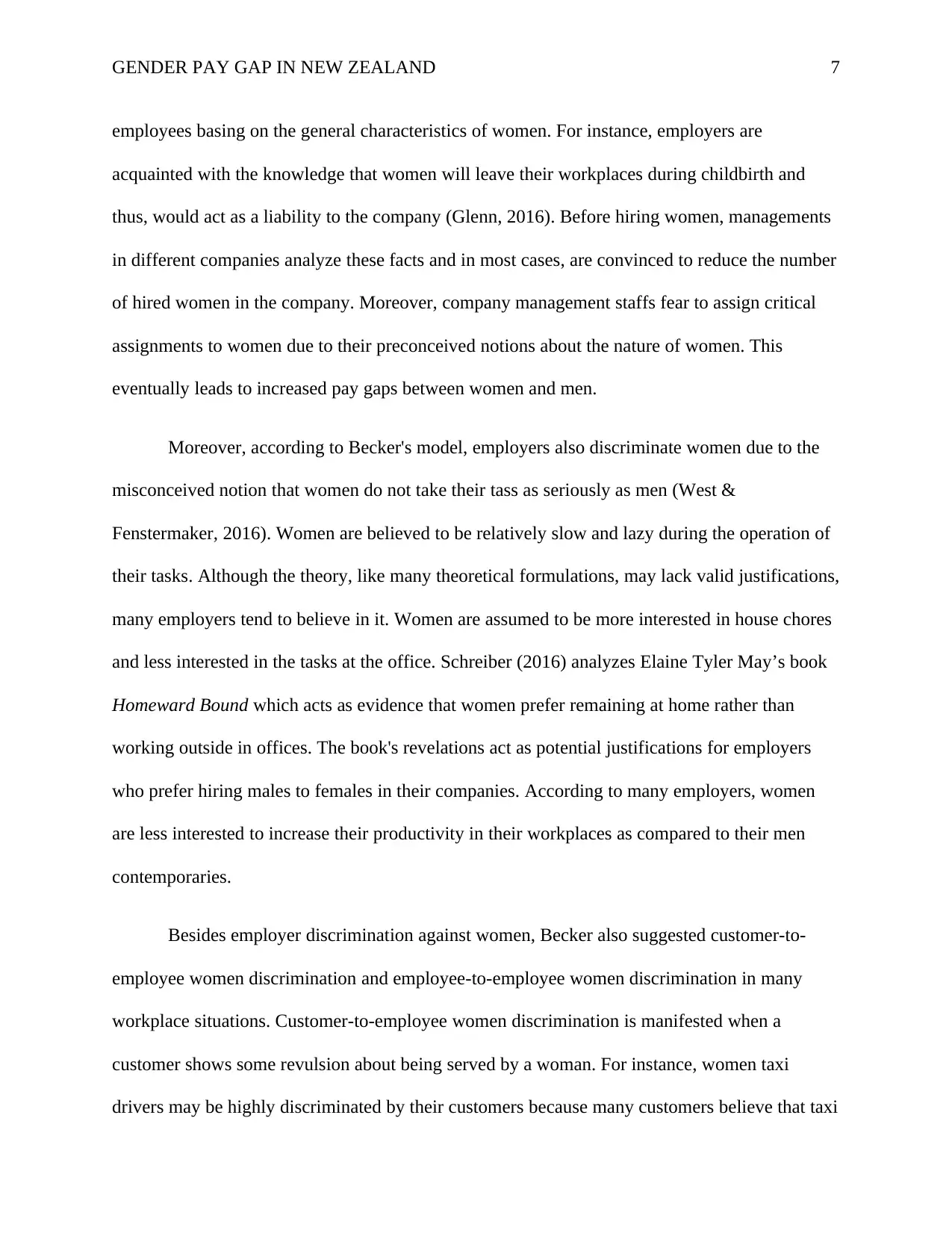
GENDER PAY GAP IN NEW ZEALAND 7
employees basing on the general characteristics of women. For instance, employers are
acquainted with the knowledge that women will leave their workplaces during childbirth and
thus, would act as a liability to the company (Glenn, 2016). Before hiring women, managements
in different companies analyze these facts and in most cases, are convinced to reduce the number
of hired women in the company. Moreover, company management staffs fear to assign critical
assignments to women due to their preconceived notions about the nature of women. This
eventually leads to increased pay gaps between women and men.
Moreover, according to Becker's model, employers also discriminate women due to the
misconceived notion that women do not take their tass as seriously as men (West &
Fenstermaker, 2016). Women are believed to be relatively slow and lazy during the operation of
their tasks. Although the theory, like many theoretical formulations, may lack valid justifications,
many employers tend to believe in it. Women are assumed to be more interested in house chores
and less interested in the tasks at the office. Schreiber (2016) analyzes Elaine Tyler May’s book
Homeward Bound which acts as evidence that women prefer remaining at home rather than
working outside in offices. The book's revelations act as potential justifications for employers
who prefer hiring males to females in their companies. According to many employers, women
are less interested to increase their productivity in their workplaces as compared to their men
contemporaries.
Besides employer discrimination against women, Becker also suggested customer-to-
employee women discrimination and employee-to-employee women discrimination in many
workplace situations. Customer-to-employee women discrimination is manifested when a
customer shows some revulsion about being served by a woman. For instance, women taxi
drivers may be highly discriminated by their customers because many customers believe that taxi
employees basing on the general characteristics of women. For instance, employers are
acquainted with the knowledge that women will leave their workplaces during childbirth and
thus, would act as a liability to the company (Glenn, 2016). Before hiring women, managements
in different companies analyze these facts and in most cases, are convinced to reduce the number
of hired women in the company. Moreover, company management staffs fear to assign critical
assignments to women due to their preconceived notions about the nature of women. This
eventually leads to increased pay gaps between women and men.
Moreover, according to Becker's model, employers also discriminate women due to the
misconceived notion that women do not take their tass as seriously as men (West &
Fenstermaker, 2016). Women are believed to be relatively slow and lazy during the operation of
their tasks. Although the theory, like many theoretical formulations, may lack valid justifications,
many employers tend to believe in it. Women are assumed to be more interested in house chores
and less interested in the tasks at the office. Schreiber (2016) analyzes Elaine Tyler May’s book
Homeward Bound which acts as evidence that women prefer remaining at home rather than
working outside in offices. The book's revelations act as potential justifications for employers
who prefer hiring males to females in their companies. According to many employers, women
are less interested to increase their productivity in their workplaces as compared to their men
contemporaries.
Besides employer discrimination against women, Becker also suggested customer-to-
employee women discrimination and employee-to-employee women discrimination in many
workplace situations. Customer-to-employee women discrimination is manifested when a
customer shows some revulsion about being served by a woman. For instance, women taxi
drivers may be highly discriminated by their customers because many customers believe that taxi
Paraphrase This Document
Need a fresh take? Get an instant paraphrase of this document with our AI Paraphraser
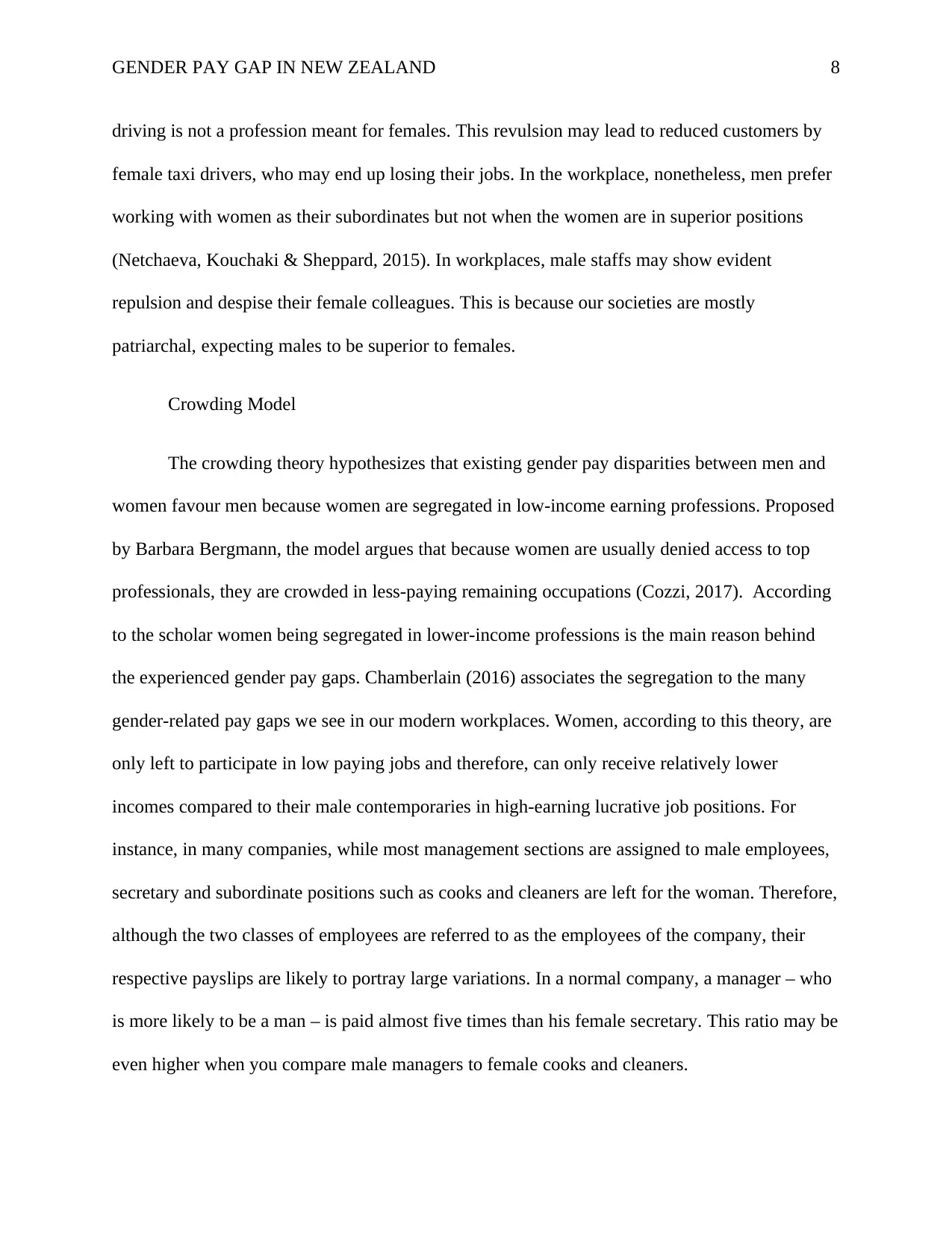
GENDER PAY GAP IN NEW ZEALAND 8
driving is not a profession meant for females. This revulsion may lead to reduced customers by
female taxi drivers, who may end up losing their jobs. In the workplace, nonetheless, men prefer
working with women as their subordinates but not when the women are in superior positions
(Netchaeva, Kouchaki & Sheppard, 2015). In workplaces, male staffs may show evident
repulsion and despise their female colleagues. This is because our societies are mostly
patriarchal, expecting males to be superior to females.
Crowding Model
The crowding theory hypothesizes that existing gender pay disparities between men and
women favour men because women are segregated in low-income earning professions. Proposed
by Barbara Bergmann, the model argues that because women are usually denied access to top
professionals, they are crowded in less-paying remaining occupations (Cozzi, 2017). According
to the scholar women being segregated in lower-income professions is the main reason behind
the experienced gender pay gaps. Chamberlain (2016) associates the segregation to the many
gender-related pay gaps we see in our modern workplaces. Women, according to this theory, are
only left to participate in low paying jobs and therefore, can only receive relatively lower
incomes compared to their male contemporaries in high-earning lucrative job positions. For
instance, in many companies, while most management sections are assigned to male employees,
secretary and subordinate positions such as cooks and cleaners are left for the woman. Therefore,
although the two classes of employees are referred to as the employees of the company, their
respective payslips are likely to portray large variations. In a normal company, a manager – who
is more likely to be a man – is paid almost five times than his female secretary. This ratio may be
even higher when you compare male managers to female cooks and cleaners.
driving is not a profession meant for females. This revulsion may lead to reduced customers by
female taxi drivers, who may end up losing their jobs. In the workplace, nonetheless, men prefer
working with women as their subordinates but not when the women are in superior positions
(Netchaeva, Kouchaki & Sheppard, 2015). In workplaces, male staffs may show evident
repulsion and despise their female colleagues. This is because our societies are mostly
patriarchal, expecting males to be superior to females.
Crowding Model
The crowding theory hypothesizes that existing gender pay disparities between men and
women favour men because women are segregated in low-income earning professions. Proposed
by Barbara Bergmann, the model argues that because women are usually denied access to top
professionals, they are crowded in less-paying remaining occupations (Cozzi, 2017). According
to the scholar women being segregated in lower-income professions is the main reason behind
the experienced gender pay gaps. Chamberlain (2016) associates the segregation to the many
gender-related pay gaps we see in our modern workplaces. Women, according to this theory, are
only left to participate in low paying jobs and therefore, can only receive relatively lower
incomes compared to their male contemporaries in high-earning lucrative job positions. For
instance, in many companies, while most management sections are assigned to male employees,
secretary and subordinate positions such as cooks and cleaners are left for the woman. Therefore,
although the two classes of employees are referred to as the employees of the company, their
respective payslips are likely to portray large variations. In a normal company, a manager – who
is more likely to be a man – is paid almost five times than his female secretary. This ratio may be
even higher when you compare male managers to female cooks and cleaners.
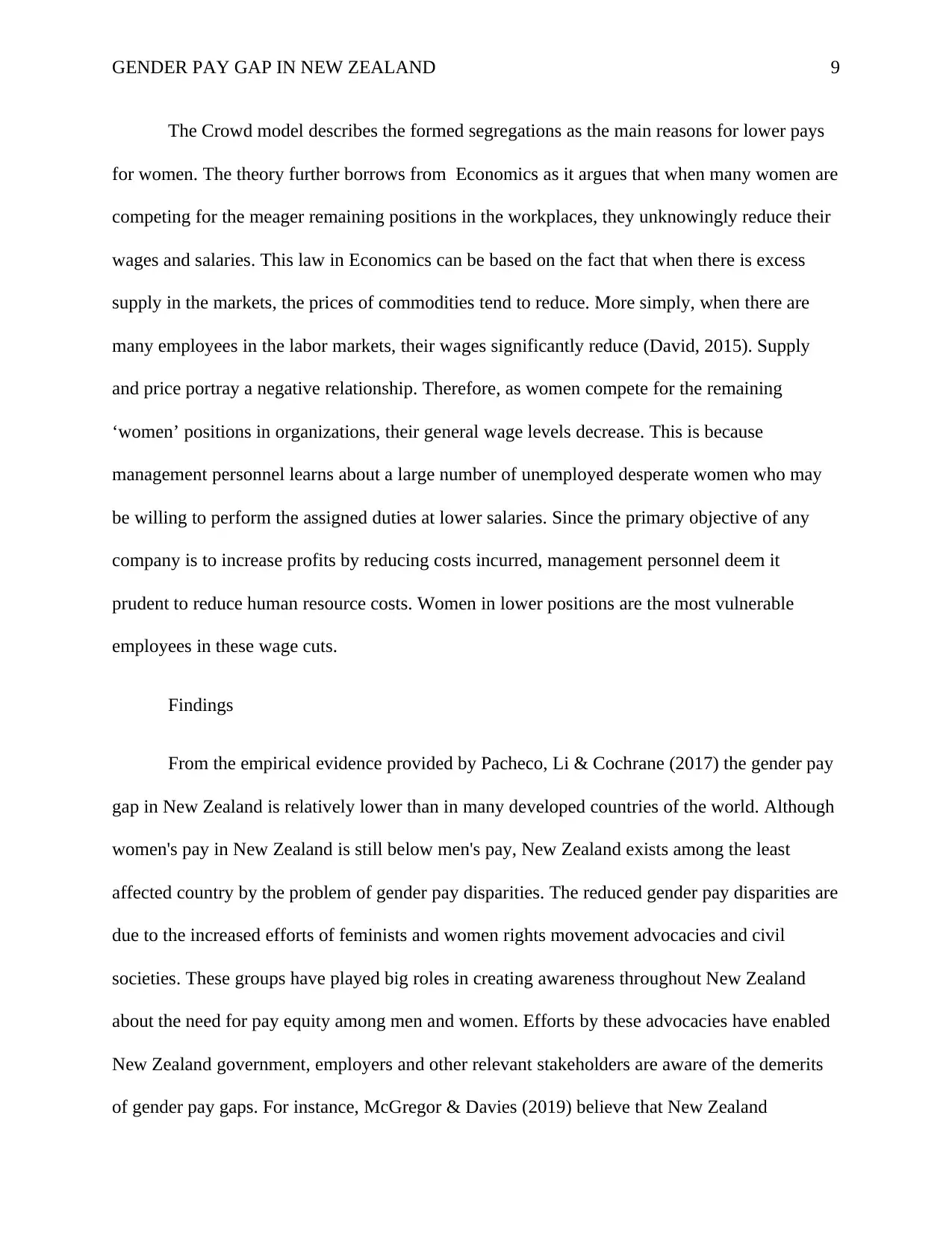
GENDER PAY GAP IN NEW ZEALAND 9
The Crowd model describes the formed segregations as the main reasons for lower pays
for women. The theory further borrows from Economics as it argues that when many women are
competing for the meager remaining positions in the workplaces, they unknowingly reduce their
wages and salaries. This law in Economics can be based on the fact that when there is excess
supply in the markets, the prices of commodities tend to reduce. More simply, when there are
many employees in the labor markets, their wages significantly reduce (David, 2015). Supply
and price portray a negative relationship. Therefore, as women compete for the remaining
‘women’ positions in organizations, their general wage levels decrease. This is because
management personnel learns about a large number of unemployed desperate women who may
be willing to perform the assigned duties at lower salaries. Since the primary objective of any
company is to increase profits by reducing costs incurred, management personnel deem it
prudent to reduce human resource costs. Women in lower positions are the most vulnerable
employees in these wage cuts.
Findings
From the empirical evidence provided by Pacheco, Li & Cochrane (2017) the gender pay
gap in New Zealand is relatively lower than in many developed countries of the world. Although
women's pay in New Zealand is still below men's pay, New Zealand exists among the least
affected country by the problem of gender pay disparities. The reduced gender pay disparities are
due to the increased efforts of feminists and women rights movement advocacies and civil
societies. These groups have played big roles in creating awareness throughout New Zealand
about the need for pay equity among men and women. Efforts by these advocacies have enabled
New Zealand government, employers and other relevant stakeholders are aware of the demerits
of gender pay gaps. For instance, McGregor & Davies (2019) believe that New Zealand
The Crowd model describes the formed segregations as the main reasons for lower pays
for women. The theory further borrows from Economics as it argues that when many women are
competing for the meager remaining positions in the workplaces, they unknowingly reduce their
wages and salaries. This law in Economics can be based on the fact that when there is excess
supply in the markets, the prices of commodities tend to reduce. More simply, when there are
many employees in the labor markets, their wages significantly reduce (David, 2015). Supply
and price portray a negative relationship. Therefore, as women compete for the remaining
‘women’ positions in organizations, their general wage levels decrease. This is because
management personnel learns about a large number of unemployed desperate women who may
be willing to perform the assigned duties at lower salaries. Since the primary objective of any
company is to increase profits by reducing costs incurred, management personnel deem it
prudent to reduce human resource costs. Women in lower positions are the most vulnerable
employees in these wage cuts.
Findings
From the empirical evidence provided by Pacheco, Li & Cochrane (2017) the gender pay
gap in New Zealand is relatively lower than in many developed countries of the world. Although
women's pay in New Zealand is still below men's pay, New Zealand exists among the least
affected country by the problem of gender pay disparities. The reduced gender pay disparities are
due to the increased efforts of feminists and women rights movement advocacies and civil
societies. These groups have played big roles in creating awareness throughout New Zealand
about the need for pay equity among men and women. Efforts by these advocacies have enabled
New Zealand government, employers and other relevant stakeholders are aware of the demerits
of gender pay gaps. For instance, McGregor & Davies (2019) believe that New Zealand
⊘ This is a preview!⊘
Do you want full access?
Subscribe today to unlock all pages.

Trusted by 1+ million students worldwide
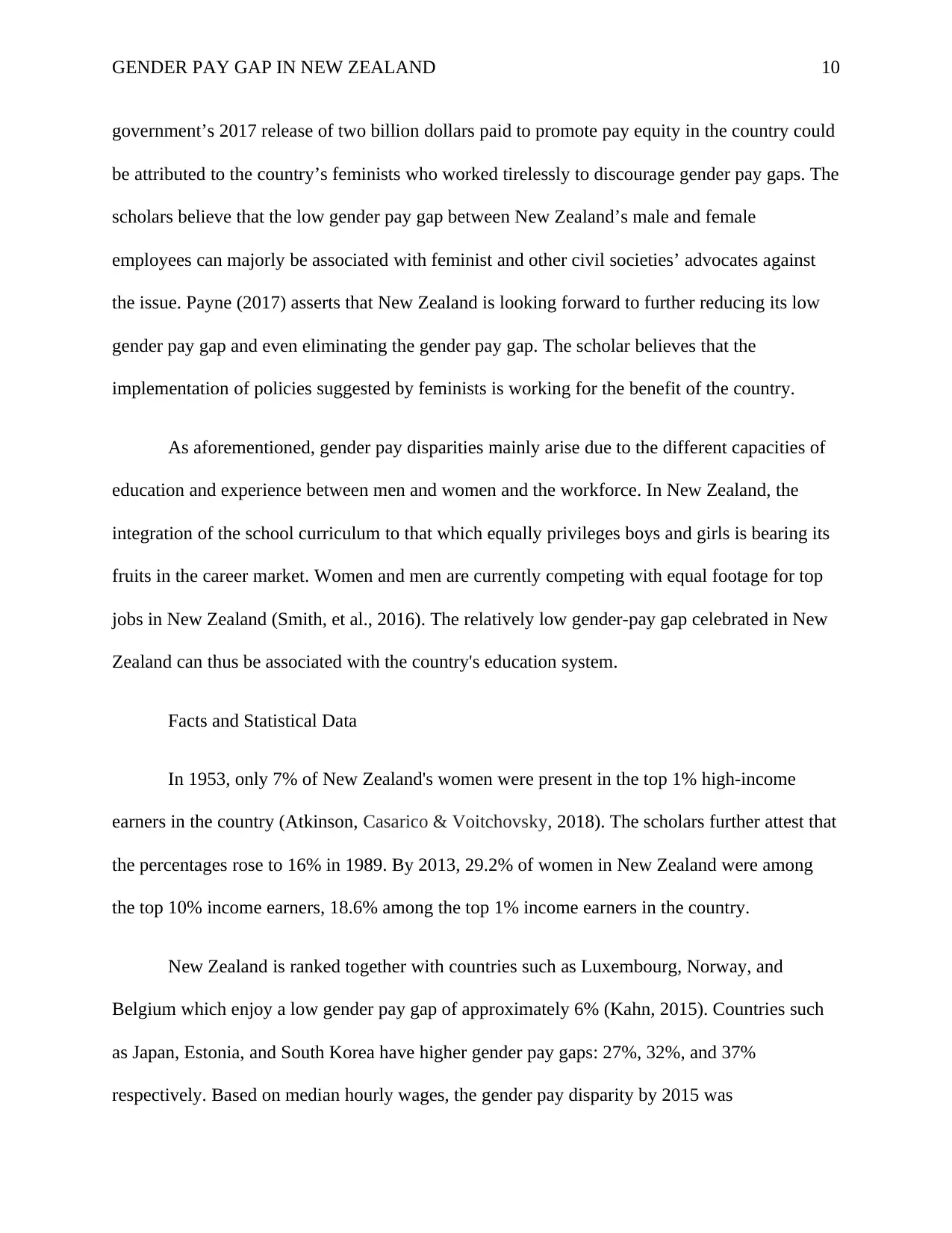
GENDER PAY GAP IN NEW ZEALAND 10
government’s 2017 release of two billion dollars paid to promote pay equity in the country could
be attributed to the country’s feminists who worked tirelessly to discourage gender pay gaps. The
scholars believe that the low gender pay gap between New Zealand’s male and female
employees can majorly be associated with feminist and other civil societies’ advocates against
the issue. Payne (2017) asserts that New Zealand is looking forward to further reducing its low
gender pay gap and even eliminating the gender pay gap. The scholar believes that the
implementation of policies suggested by feminists is working for the benefit of the country.
As aforementioned, gender pay disparities mainly arise due to the different capacities of
education and experience between men and women and the workforce. In New Zealand, the
integration of the school curriculum to that which equally privileges boys and girls is bearing its
fruits in the career market. Women and men are currently competing with equal footage for top
jobs in New Zealand (Smith, et al., 2016). The relatively low gender-pay gap celebrated in New
Zealand can thus be associated with the country's education system.
Facts and Statistical Data
In 1953, only 7% of New Zealand's women were present in the top 1% high-income
earners in the country (Atkinson, Casarico & Voitchovsky, 2018). The scholars further attest that
the percentages rose to 16% in 1989. By 2013, 29.2% of women in New Zealand were among
the top 10% income earners, 18.6% among the top 1% income earners in the country.
New Zealand is ranked together with countries such as Luxembourg, Norway, and
Belgium which enjoy a low gender pay gap of approximately 6% (Kahn, 2015). Countries such
as Japan, Estonia, and South Korea have higher gender pay gaps: 27%, 32%, and 37%
respectively. Based on median hourly wages, the gender pay disparity by 2015 was
government’s 2017 release of two billion dollars paid to promote pay equity in the country could
be attributed to the country’s feminists who worked tirelessly to discourage gender pay gaps. The
scholars believe that the low gender pay gap between New Zealand’s male and female
employees can majorly be associated with feminist and other civil societies’ advocates against
the issue. Payne (2017) asserts that New Zealand is looking forward to further reducing its low
gender pay gap and even eliminating the gender pay gap. The scholar believes that the
implementation of policies suggested by feminists is working for the benefit of the country.
As aforementioned, gender pay disparities mainly arise due to the different capacities of
education and experience between men and women and the workforce. In New Zealand, the
integration of the school curriculum to that which equally privileges boys and girls is bearing its
fruits in the career market. Women and men are currently competing with equal footage for top
jobs in New Zealand (Smith, et al., 2016). The relatively low gender-pay gap celebrated in New
Zealand can thus be associated with the country's education system.
Facts and Statistical Data
In 1953, only 7% of New Zealand's women were present in the top 1% high-income
earners in the country (Atkinson, Casarico & Voitchovsky, 2018). The scholars further attest that
the percentages rose to 16% in 1989. By 2013, 29.2% of women in New Zealand were among
the top 10% income earners, 18.6% among the top 1% income earners in the country.
New Zealand is ranked together with countries such as Luxembourg, Norway, and
Belgium which enjoy a low gender pay gap of approximately 6% (Kahn, 2015). Countries such
as Japan, Estonia, and South Korea have higher gender pay gaps: 27%, 32%, and 37%
respectively. Based on median hourly wages, the gender pay disparity by 2015 was
Paraphrase This Document
Need a fresh take? Get an instant paraphrase of this document with our AI Paraphraser
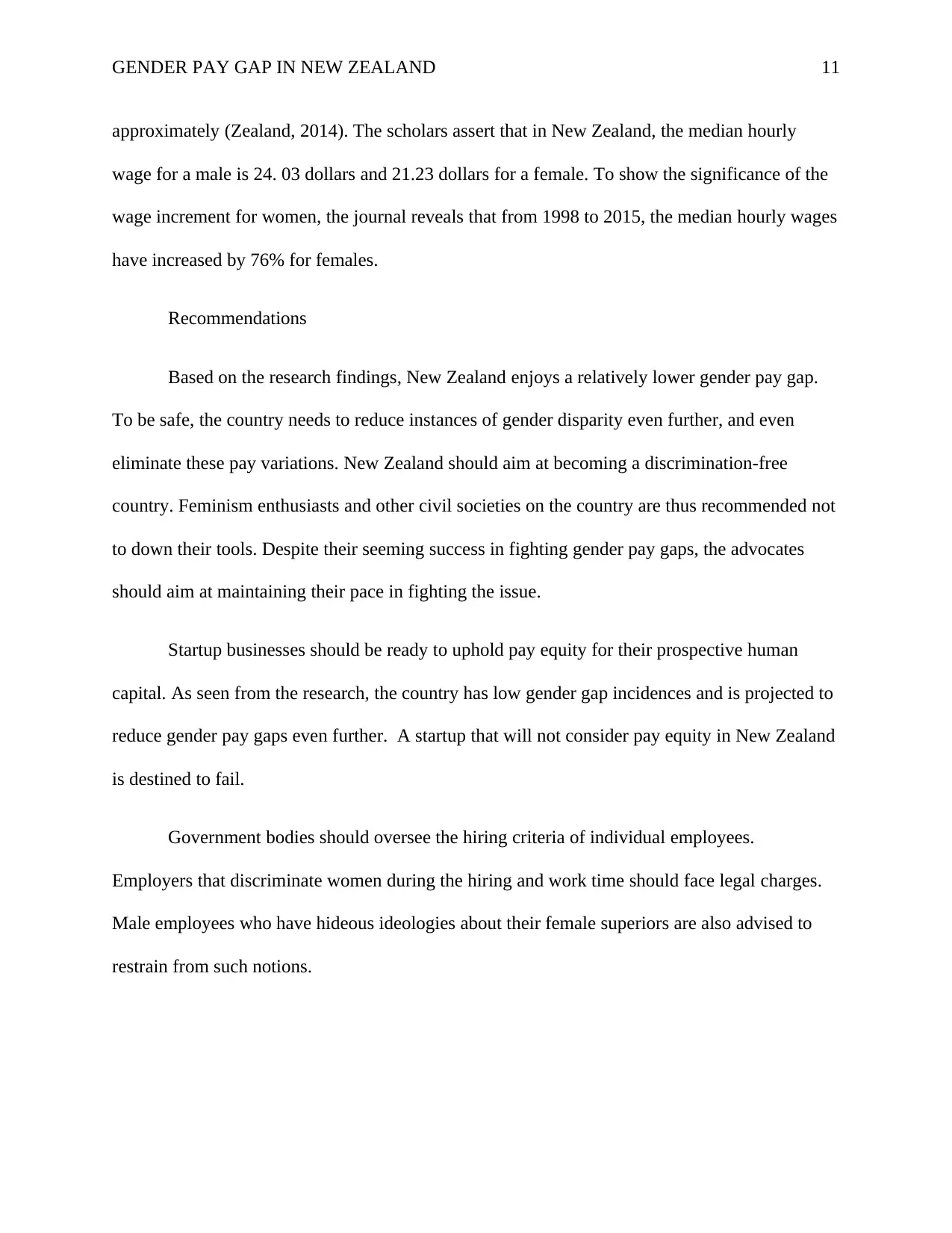
GENDER PAY GAP IN NEW ZEALAND 11
approximately (Zealand, 2014). The scholars assert that in New Zealand, the median hourly
wage for a male is 24. 03 dollars and 21.23 dollars for a female. To show the significance of the
wage increment for women, the journal reveals that from 1998 to 2015, the median hourly wages
have increased by 76% for females.
Recommendations
Based on the research findings, New Zealand enjoys a relatively lower gender pay gap.
To be safe, the country needs to reduce instances of gender disparity even further, and even
eliminate these pay variations. New Zealand should aim at becoming a discrimination-free
country. Feminism enthusiasts and other civil societies on the country are thus recommended not
to down their tools. Despite their seeming success in fighting gender pay gaps, the advocates
should aim at maintaining their pace in fighting the issue.
Startup businesses should be ready to uphold pay equity for their prospective human
capital. As seen from the research, the country has low gender gap incidences and is projected to
reduce gender pay gaps even further. A startup that will not consider pay equity in New Zealand
is destined to fail.
Government bodies should oversee the hiring criteria of individual employees.
Employers that discriminate women during the hiring and work time should face legal charges.
Male employees who have hideous ideologies about their female superiors are also advised to
restrain from such notions.
approximately (Zealand, 2014). The scholars assert that in New Zealand, the median hourly
wage for a male is 24. 03 dollars and 21.23 dollars for a female. To show the significance of the
wage increment for women, the journal reveals that from 1998 to 2015, the median hourly wages
have increased by 76% for females.
Recommendations
Based on the research findings, New Zealand enjoys a relatively lower gender pay gap.
To be safe, the country needs to reduce instances of gender disparity even further, and even
eliminate these pay variations. New Zealand should aim at becoming a discrimination-free
country. Feminism enthusiasts and other civil societies on the country are thus recommended not
to down their tools. Despite their seeming success in fighting gender pay gaps, the advocates
should aim at maintaining their pace in fighting the issue.
Startup businesses should be ready to uphold pay equity for their prospective human
capital. As seen from the research, the country has low gender gap incidences and is projected to
reduce gender pay gaps even further. A startup that will not consider pay equity in New Zealand
is destined to fail.
Government bodies should oversee the hiring criteria of individual employees.
Employers that discriminate women during the hiring and work time should face legal charges.
Male employees who have hideous ideologies about their female superiors are also advised to
restrain from such notions.
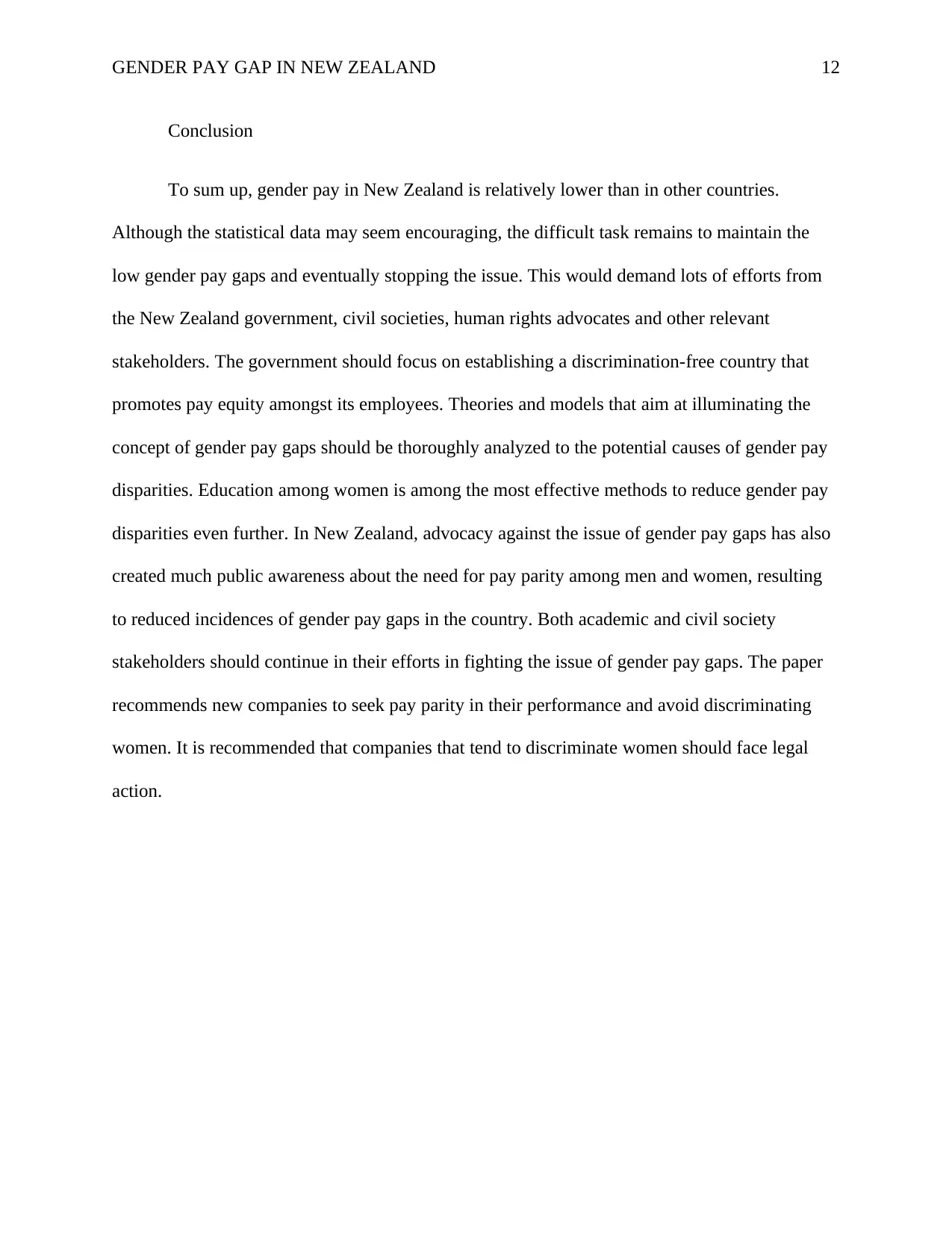
GENDER PAY GAP IN NEW ZEALAND 12
Conclusion
To sum up, gender pay in New Zealand is relatively lower than in other countries.
Although the statistical data may seem encouraging, the difficult task remains to maintain the
low gender pay gaps and eventually stopping the issue. This would demand lots of efforts from
the New Zealand government, civil societies, human rights advocates and other relevant
stakeholders. The government should focus on establishing a discrimination-free country that
promotes pay equity amongst its employees. Theories and models that aim at illuminating the
concept of gender pay gaps should be thoroughly analyzed to the potential causes of gender pay
disparities. Education among women is among the most effective methods to reduce gender pay
disparities even further. In New Zealand, advocacy against the issue of gender pay gaps has also
created much public awareness about the need for pay parity among men and women, resulting
to reduced incidences of gender pay gaps in the country. Both academic and civil society
stakeholders should continue in their efforts in fighting the issue of gender pay gaps. The paper
recommends new companies to seek pay parity in their performance and avoid discriminating
women. It is recommended that companies that tend to discriminate women should face legal
action.
Conclusion
To sum up, gender pay in New Zealand is relatively lower than in other countries.
Although the statistical data may seem encouraging, the difficult task remains to maintain the
low gender pay gaps and eventually stopping the issue. This would demand lots of efforts from
the New Zealand government, civil societies, human rights advocates and other relevant
stakeholders. The government should focus on establishing a discrimination-free country that
promotes pay equity amongst its employees. Theories and models that aim at illuminating the
concept of gender pay gaps should be thoroughly analyzed to the potential causes of gender pay
disparities. Education among women is among the most effective methods to reduce gender pay
disparities even further. In New Zealand, advocacy against the issue of gender pay gaps has also
created much public awareness about the need for pay parity among men and women, resulting
to reduced incidences of gender pay gaps in the country. Both academic and civil society
stakeholders should continue in their efforts in fighting the issue of gender pay gaps. The paper
recommends new companies to seek pay parity in their performance and avoid discriminating
women. It is recommended that companies that tend to discriminate women should face legal
action.
⊘ This is a preview!⊘
Do you want full access?
Subscribe today to unlock all pages.

Trusted by 1+ million students worldwide
1 out of 15
Related Documents
Your All-in-One AI-Powered Toolkit for Academic Success.
+13062052269
info@desklib.com
Available 24*7 on WhatsApp / Email
![[object Object]](/_next/static/media/star-bottom.7253800d.svg)
Unlock your academic potential
Copyright © 2020–2025 A2Z Services. All Rights Reserved. Developed and managed by ZUCOL.





